Impact of Electric Vehicles as Distributed Energy Storage in Isolated Systems: The Case of Tenerife
Abstract
:1. Introduction
2. Vehicle to Grid and Energy Storage in Isolated Systems
3. The Electric Power System on Tenerife: Description and Model Simulation
3.1. Tenerife Electric Power System
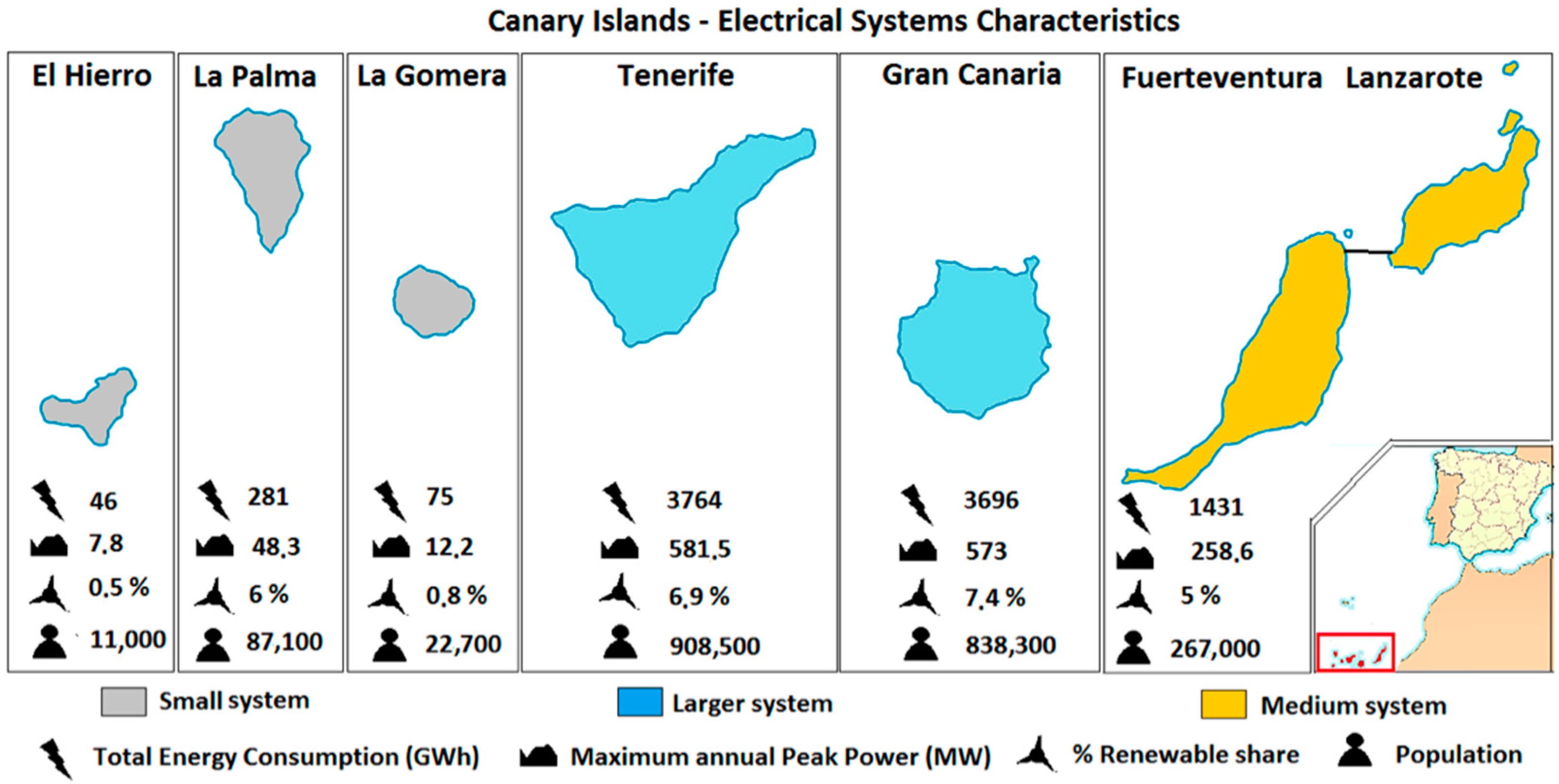
| Technology | No. | Power per Unit | Total Power | Minimum Operation Range | LCOE | Type of Fuel Used | Emissions Rate |
|---|---|---|---|---|---|---|---|
| MW | MW | MW | €/MWh | - | KgCO2/MWh | ||
| Combined Cycle | 2 | 220 | 440 | 110 | 169 | Gas Oil | 650–700 |
| Steam Turbine | 3 | 80 | 240 | 45 | 165 | Fuel Oil | 850–900 |
| Gas Turbine | 6 | 35 | 210 | 8 | 320 | Gas Oil | 1200–1250 |
| Diesel Engines | 3 | 24 | 72 | 12 | 130 | Fuel Oil | 750–800 |
| Wind Power | - | - | 37 | - | 72 | - | - |
| Photovoltaic | - | - | 114 | - | 118 | - | - |

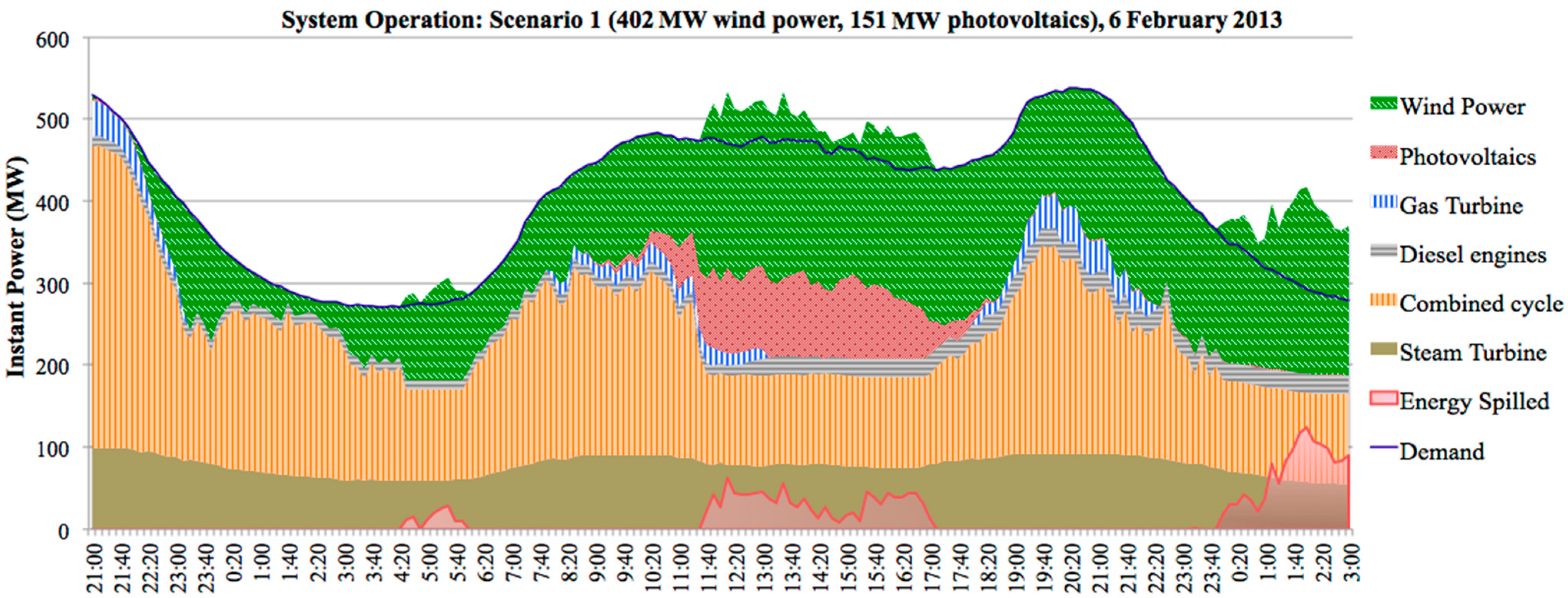
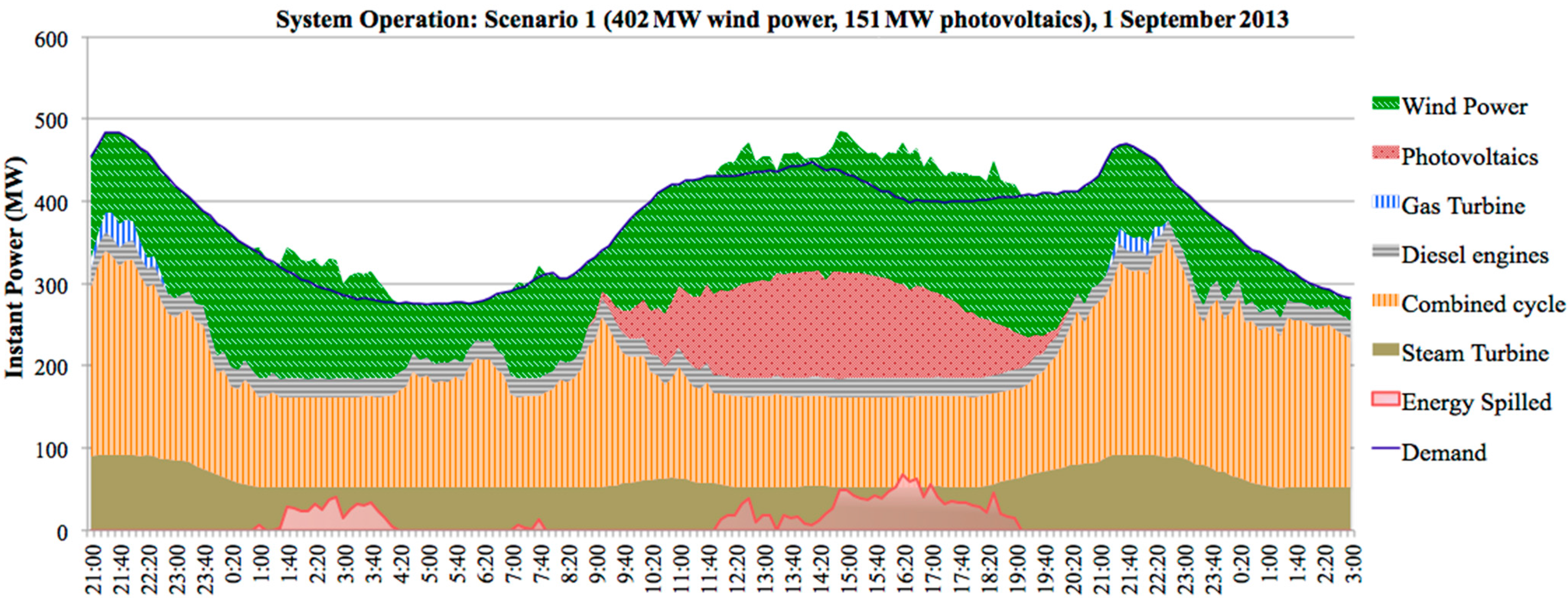
3.2. Methodology: Simulation of the Electric Power System on Tenerife
3.2.1. Scenarios
3.2.2. The Simulation Strategy
3.2.3. EV Fleet Characterization
| PARAMETER | ABBREV | UNITS | QUANTITY |
|---|---|---|---|
| Average millage in road transport | ECroad | kWh/km | 0.18 |
| Number of EVs | NEV | - | 10,000/25,000/50,000 |
| EVs’ total storage capacity (10,000; 25,000; 50,000) | SEV | MWh | 204/510/1020 |
| Minimum operation state of charge | SOCsec | % | 15 |
| Efficiency of the charger | Eff | % | 86 |
| Number of charging points at home | Nhome | - | 10,000/25,000/50,000 |
| Number of charging points at the workplace | Nwork | - | 500/1500/3000 |
| Power of the charging point at home | Phome | kW | 7 |
| Power of the charging point at the workplace | Phome | kW | 22 |
| Total V2G installed capacity (Scenarios 4 and 5) | Pv2g | MW | 208/416 |
| Average distance travelled (weekdays/weekends) | Dtrav | km | 35/40 |
| Minimum demand required for injection in peaks | Pmin, peak | MW | 450 |
| Minimum renewable drops for the reserves | Fmin, backup | MW | 15 |
| Minimum state of charge to inject energy | SOCmin, V2G | % | 40 |
4. Results and Discussion
4.1. An Increase of Renewables Installed Capacity on Tenerife
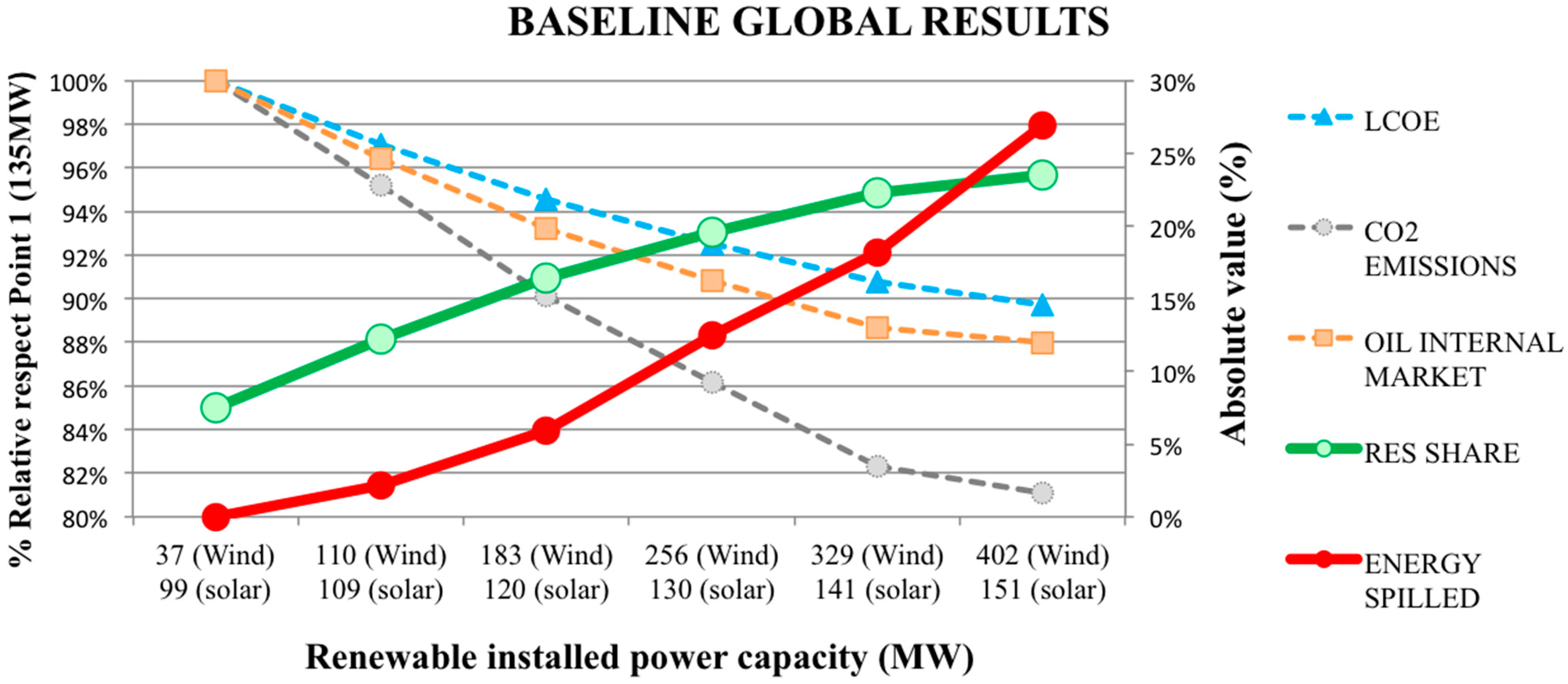
4.2. Scenarios Using an EV Fleet
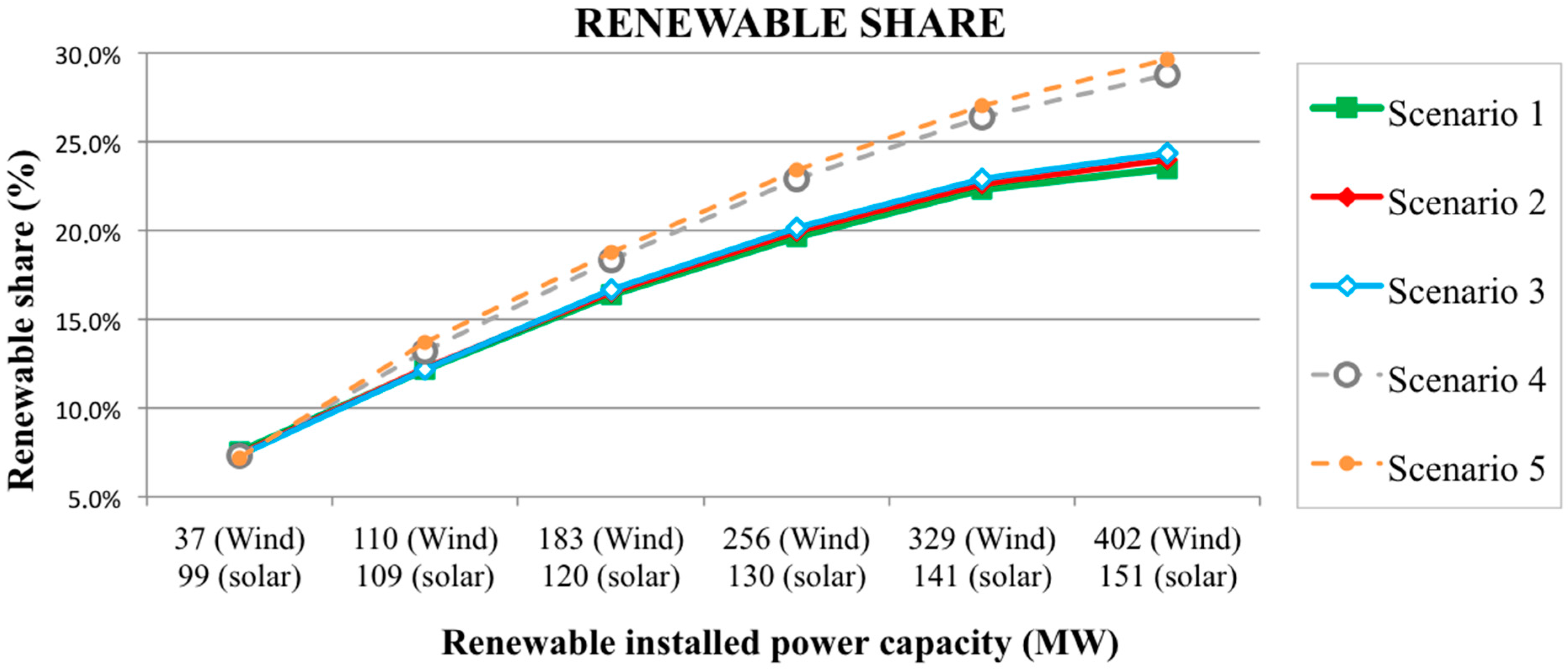
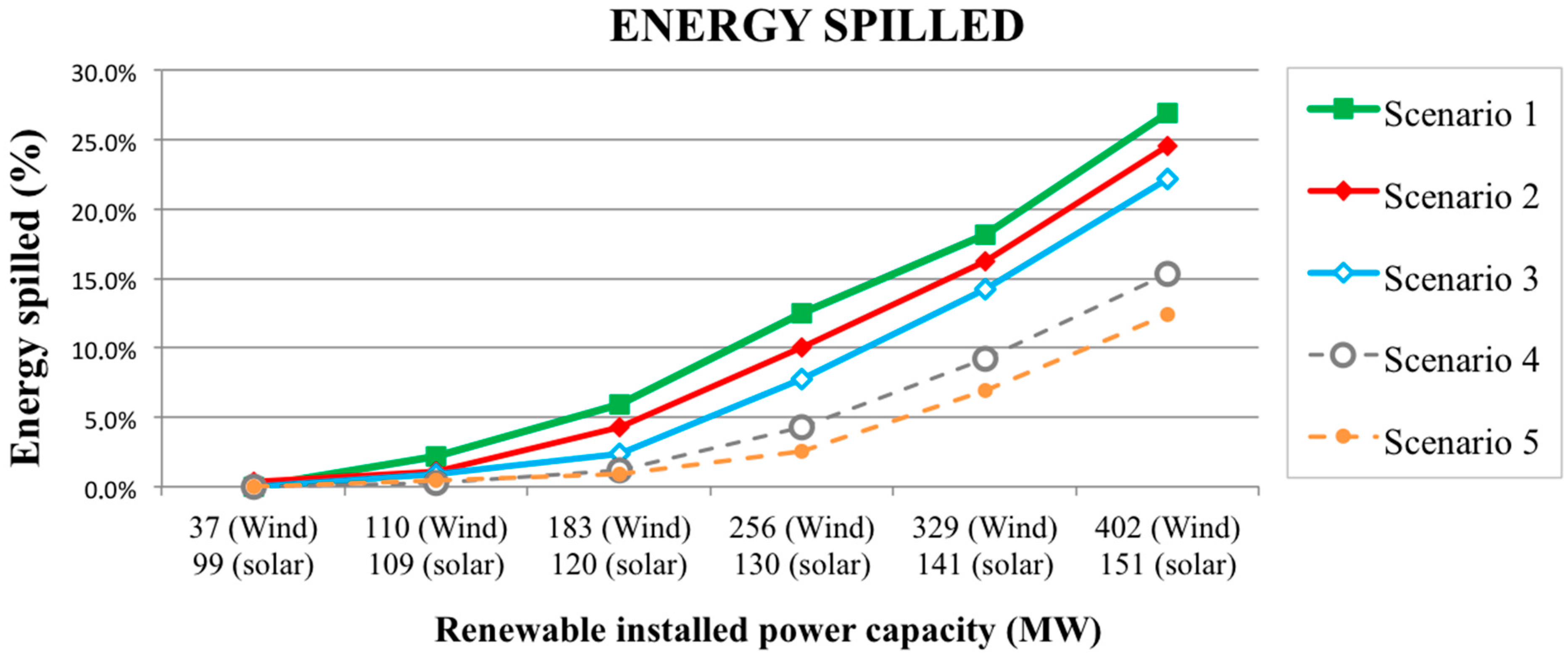
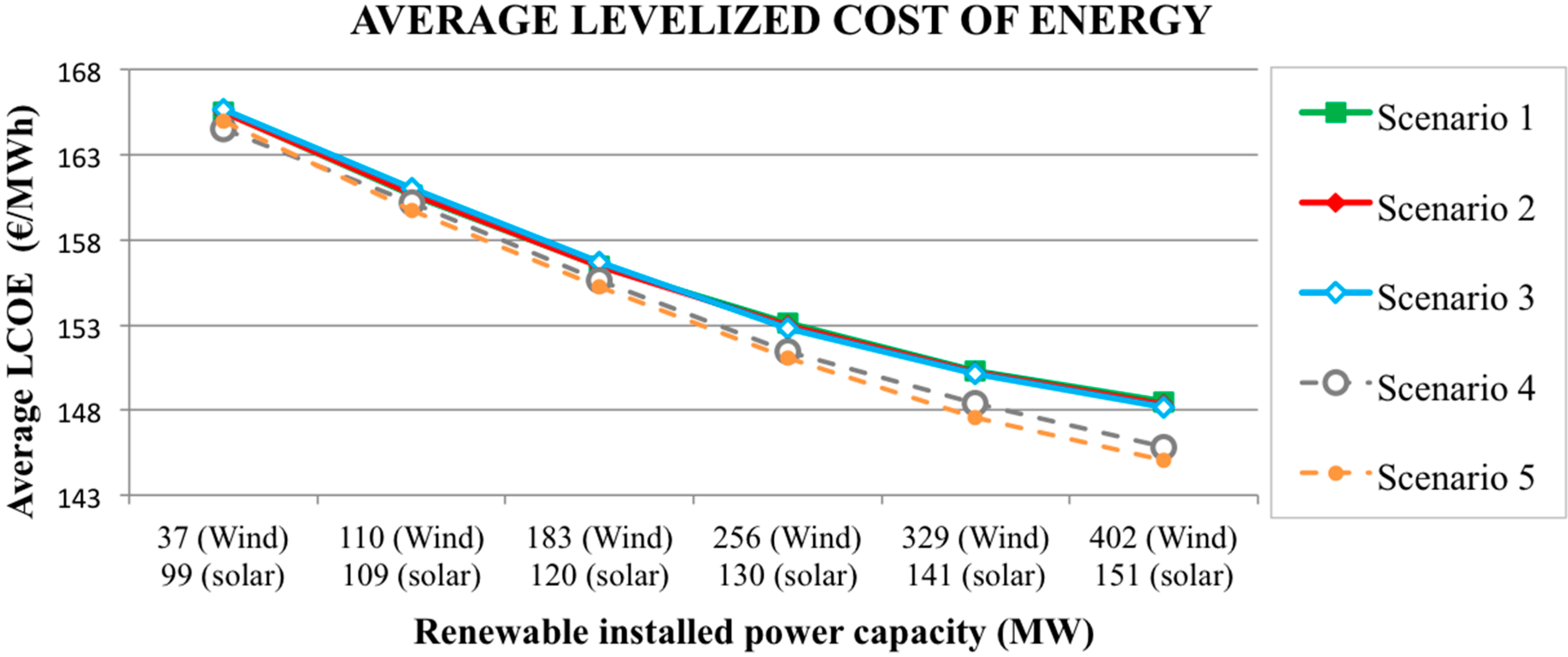
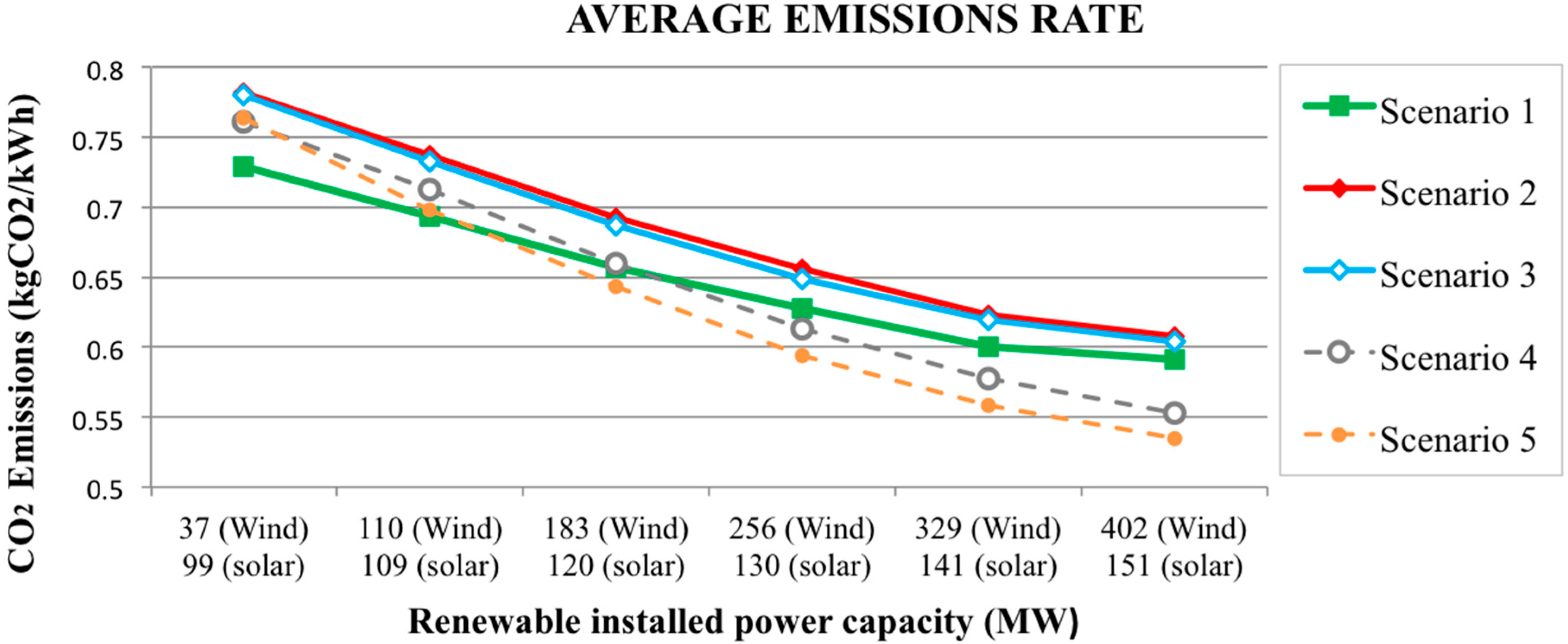

| RES | Renewable Share | LCOE | CO2 Emissions | Energy Spilled | Oil Internal Market | ||||||
|---|---|---|---|---|---|---|---|---|---|---|---|
| MW | S1 | S5 | S1 | S5 | S1 | S5 | S1 | S5 | S1 | S5 | |
| 1 | 135 | 0.0% | 0.0% | 0.0% | 0.0% | 0.0% | 0.0% | 0.0% | 0.0% | 0.0% | 0.0% |
| 2 | 219 | 4.7% | 6.5% | −2.9% | −3.2% | −4.8% | −9.1% | 2.2% | 0.5% | −3.6% | −4.3% |
| 3 | 303 | 4.2% | 5.1% | −2.5% | −2.7% | −5.1% | −7.5% | 3.7% | 0.4% | −3.2% | −3.8% |
| 4 | 386 | 3.2% | 4.6% | −2.0% | −2.5% | −4.0% | −6.7% | 6.6% | 1.6% | −2.4% | −3.1% |
| 5 | 470 | 2.7% | 3.6% | −1.7% | −2.1% | −3.8% | −4.9% | 5.6% | 4.4% | −2.2% | −1.9% |
| 6 | 553 | 1.2% | 2.6% | −1.1% | −1.5% | −1.2% | −3.2% | 8.8% | 5.5% | −0.7% | −1.2% |
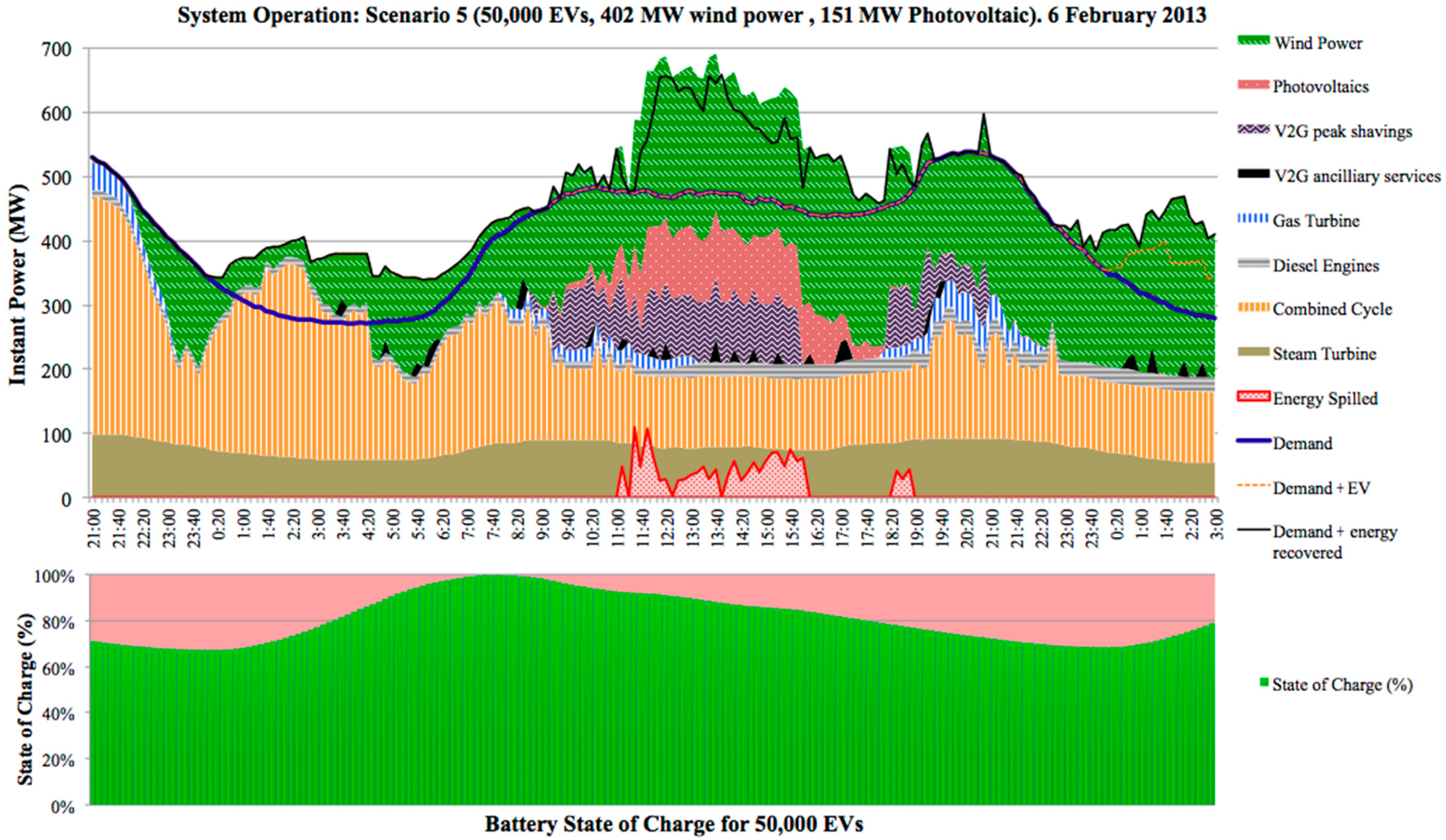
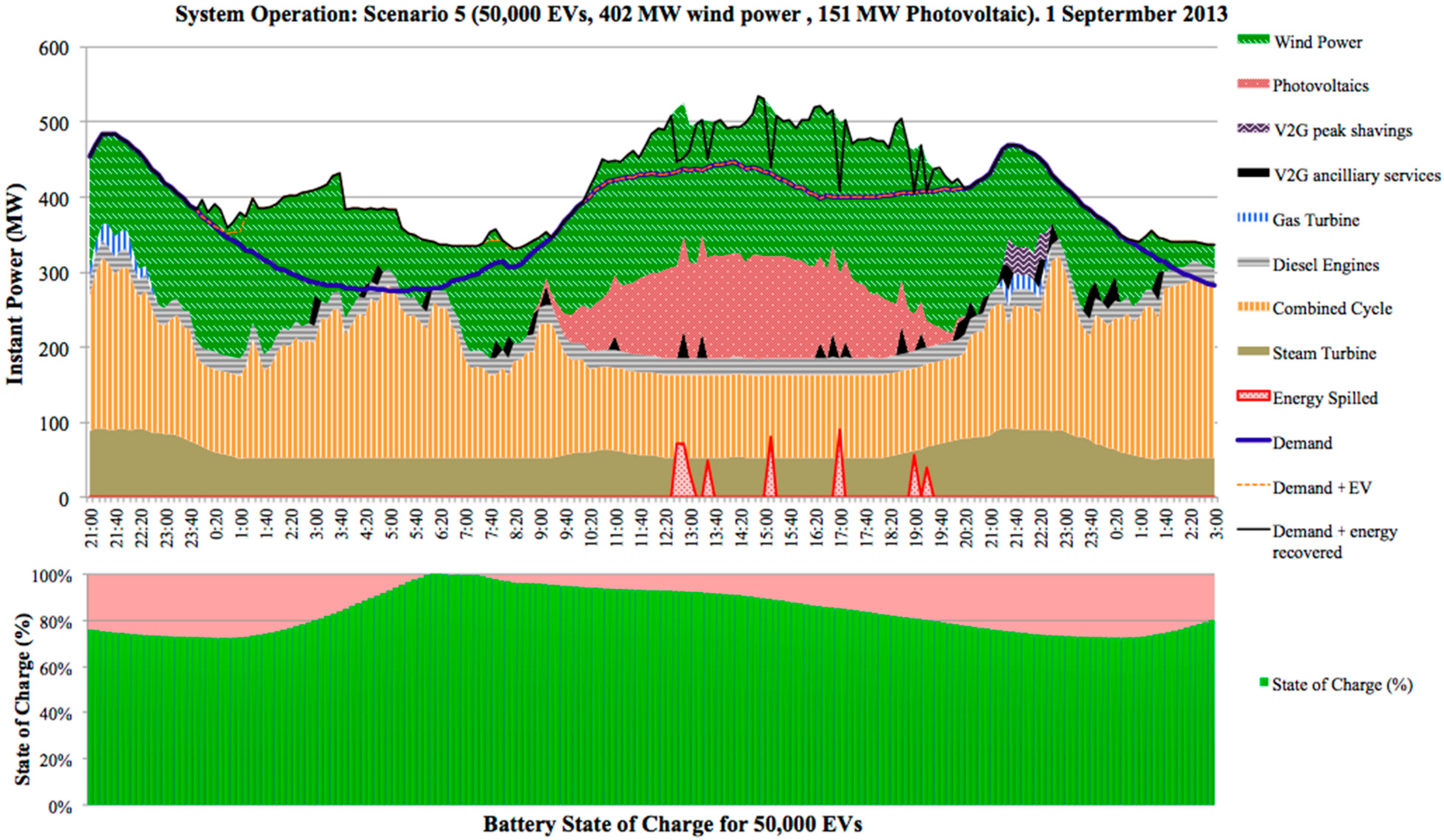
5. Conclusions
Acknowledgments
Author Contributions
Conflicts of Interest
Appendix 1. Levelized Cost of Energy of the Different Technologies on Tenerife
| Variable | Capital Cost | N | D | CRF | Capacity Factor | T | Investment Cost (Overnight) | Fixed Cost O&M | Variable Cost O&M | Plant Efficiency | Fuel Price | Intermittency Price | CO2/Price | Levelized Cost of Energy | ||||||||||
|---|---|---|---|---|---|---|---|---|---|---|---|---|---|---|---|---|---|---|---|---|---|---|---|---|
| Units | €/kW | years | % | L/years | % | % | % | €/MWh | €/MWh | €/MWh | % | % | €/MWh | €/MWh | €/MWh | €/MWh | ||||||||
| min | max | average | min | max | min | max | average | average | average | min | max | min | max | average | average | average | min | max | average | |||||
| Combined Cycle | 1000 | 1092 | 1046 | 20 | 7 | 0.094 | 45 | 60 | 0.392 | 23.2 | 33.8 | 28.5 | 1.13 | 3.2 | 42 | 47 | 103.3 | 160.6 | 131.1 | 0 | 4.55 | 134.3 | 204.4 | 169.38 |
| Steam Turbine | 0 | 0 | 0 | 20 | 7 | 0.094 | 18 | 24 | 0.392 | 0.0 | 0.0 | 0 | 20.28 | 11.22 | 30 | 35 | 107.7 | 159.3 | 124.1 | 0 | 7.7 | 127.4 | 202.8 | 165.12 |
| Gas Turbine | 325 | 770 | 5475 | 20 | 7 | 0.094 | 20 | 25 | 0.392 | 17.7 | 52.3 | 35.0 | 7.19 | 7.0 | 20 | 26 | 186.8 | 337.3 | 275.3 | 0 | 8.75 | 220.6 | 419.5 | 320.01 |
| Diesel Engines | 0 | 0 | 0 | 20 | 7 | 0.094 | 40 | 50 | 0.392 | 0.0 | 0.0 | 0 | 13.35 | 15.02 | 38 | 46 | 82.0 | 125.8 | 98.0 | 0 | 5.6 | 104.3 | 156.0 | 130.17 |
| Wind Power | 950 | 1200 | 1075 | 20 | 7 | 0.094 | 29 | 33 | 0.392 | 34.4 | 49.4 | 41.9 | 13.92 | 0 | 100 | 100 | 0 | 0 | 0 | 16 | 0 | 62.5 | 81.2 | 71.84 |
| Photovoltaic | 1300 | 1600 | 1450 | 20 | 7 | 0.094 | 16 | 18 | 0.392 | 86.3 | 119.5 | 102.9 | 11.25 | 0 | 100 | 100 | 0 | 0 | 0 | 4 | 0 | 98.5 | 137.7 | 118.12 |
| V2G | 800 | 1200 | 1000 | 20 | 7 | 0.094 | 16 | 16 | 0.392 | 53.9 | 80.8 | 67.34 | 40.20 | 0 | 100 | 100 | 0 | 0 | 0 | 0 | 0 | 74.9 | 140.2 | 107.55 |
Appendix 2. Energy Storage Formulation
References
- Lynge, J.T. Renewable Energy on Small Islands, 2nd ed.; Forum for Energy and Development (FED): Copenhagen, Denmark, 2000; ISBN 87-90502-03-5. [Google Scholar]
- Perez, Y.; Ramos-Real, F.J. How to make a European integrated market in small and isolated electricity systems? The case of Canary Islands. Energy Policy 2008, 36, 4159–4167. [Google Scholar] [CrossRef]
- United Nations Developing Programme (UNDP). Barbados Declaration on Achieving Sustainable Energy for All in Small Island Developing States (SIDS); UN Publication: Bridgetown, Barbados, 2012. [Google Scholar]
- Anuario Energético de Canarias, 2013. Consejería de Empleo, Industria y Turismo del Gobierno de Canarias. Available online: http://www.gobcan.es/ceic/energia/galerias/ficheros/20141125-A-ENERGETICO-CANARIAS-2013.pdf (accessed on 12 November 2015).
- IRENA: Renewable Energy Opportunities for Island Tourism. Available online: http://www.irena.org/DocumentDownloads/Publications/IRENA_RE_Island_Tourism_report_2014.pdf (accessed on 12 November 2015).
- Dornan, M. Renewable energy development in small island developing states of the pacific resources. Resources 2015, 4, 490–506. [Google Scholar] [CrossRef]
- Weisser, D. Power sector reform in small island developing states: What role for renewable energy technologies? Renew. Sustain. Energy Rev. 2004, 8, 107–127. [Google Scholar] [CrossRef]
- REE (Red Electrica de España). Aplicación demanda en tiempo real (Tenerife) año 2013. Available online: https://demanda.ree.es/visionaCan/VisionaTenerife.html (accessed on 12 November 2015).
- IRENA: Renewable Energy Country Profiles—Special edition on islands. Available online: http://www.irena.org/DocumentDownloads/Publications/Country_profiles_special_edition-islands.pdf (accessed on 12 November 2015).
- Elahee, M.K. Sustainable energy policy for small-island developing state: Mauritius. Utility Policy 2011, 19, 71–79. [Google Scholar] [CrossRef]
- Szabo, S.; Kougias, I.; Moner-Girona, M.; Bódis, K. Sustainable energy portfolios for small island states. Sustainability 2015, 7, 12340–12358. [Google Scholar] [CrossRef] [Green Version]
- Red Eléctrica de España. E-sios, 2013. Costes de producción en las Islas Canarias año 2013. Available online: http://www.esios.ree.es/web-publica/ (accessed on 12 November 2015).
- Marrero, G.A.; Ramos-Real, F.J. Electricity generation cost in isolated system: The complementarities of natural gas and renewables in the Canary Islands. Sustain. Energy Rev. 2010, 14, 2808–2818. [Google Scholar] [CrossRef]
- Ramos-Real, F.J.; Moreno-Piquero, J.C.; Ramos-Henríquez, J.M. The effects of introducing natural gas in the Canary Islands for electricity generation. Energy Policy 2007, 35, 3925–3935. [Google Scholar] [CrossRef]
- Marrero, G.A.; Perez, Y.; Petit, M.; Ramos-Real, F.J. Electric vehicle fleet contributions for isolated systems. The case of Canary Islands. Int. J. Automot. Technol. Manag. 2015, 15, 171–193. [Google Scholar] [CrossRef]
- Guerrero-Lemus, R.; Benjamin, S. Study of the new Spanish legislation applied to an insular system that has achieved grid parity on PV and wind energy. Renew. Sustain. Energy Rev. 2015, 49, 426–436. [Google Scholar] [CrossRef]
- Rious, V.; Perez, Y. Review of supporting scheme for island power system storage. Renew. Sustain. Energy Rev. 2014, 29, 754–765. [Google Scholar] [CrossRef]
- PECAN, Plan Energético de Canarias 2006. Consejería de Industria, Comercio y Nuevas Tecnologías. Dirección General de Industria y Energía. Available online: http://www.gobcan.es/ceic/energia/doc/planificacion/pecan/DOCUMENTO_REVISION_PECAN2006.pdf (accessed on 12 November 2015).
- Kempton, W.; Letendre, S. The V2G concept: A new for model power? Connecting utility infrastructure and automobiles. Public Util. Fortn. 1996, 140, 16–26. [Google Scholar]
- Dietrich, K.; Latorre, J.M.; Olmos, L.; Ramos, A. Demand response in an isolated system with high wind integration. IEEE Trans. Power Syst. 2012, 27, 20–29. [Google Scholar] [CrossRef]
- Kempton, W.; Tomic, J. Vehicle-to-grid power fundamentals: Calculating capacity and net revenue. J. Power Sources 2005, 144, 268–279. [Google Scholar] [CrossRef]
- Turton, H.; Moura, F. Vehicle to grid systems for sustainable development: An integrated energy analisys. Technol. Forecast. Soc. Chang. 2008, 75, 1091–1108. [Google Scholar] [CrossRef]
- Farhoodnea, M.; Mohamed, A.; Shareef, H.; Zayandehrodi, H. Power quality impacts of high-penetration electric vehicle stations an renewable energy-based generators on power distribution systems. Measurement 2013, 46, 2423–2434. [Google Scholar] [CrossRef]
- Dang, X.L.; Petit, M.; Codani, P. Transformer operation conditions under introduction of PV and EVs in an eco-district. In Proceedings of the 2015 IEEE Power & Energy Society General Meeting, Denver, CO, USA, 26–30 July 2015; pp. 1–5.
- Haidar, A.M.A.; Muttaqi, K.M.; Sutanto, D. Technical challenges for electric power industries due to grid-integrated electric vehicles in low voltage distributions: A review. Energy Convers. Manag. 2014, 86, 689–700. [Google Scholar] [CrossRef]
- Rodrigues, E.M.G.; Godina, R.; Santos, S.F.; Bizuayehu, A.W.; Contreras, J.; Catalao, J.P.S. Energy storage systems supporting increased penetration of renewables in islanded systems. Energy 2014, 75, 265–280. [Google Scholar] [CrossRef]
- Camus, C.; Farias, T. The electric vehicles as a mean to reduce co2 emissions and energy cost in isolated regions. The Sao Miguel (Azores) case study. Energy Policy 2012, 43, 153–165. [Google Scholar] [CrossRef]
- Blyth, P.L. Electric Cars on the 100% Renewable Energy Island of Samsoe. February 2011. Available online: http://projekter.aau.dk/projekter/files/52872570/SEPM4_2011_8.pdf (accessed on 12 November 2015).
- McCarville, M. The Emergence of Electric Vehicles on Prince Edward Island and Potential Scenarios to 2030. A Guide for Policy Development. August 2009. Working Paper. Available online: http://www.ecopei.ca/The_Emergence_of_Electric_Vehicles_on_Prince_Edward_Island_v1.1 (accessed on 12 November 2015).
- Bueno, C.; Carta, J.A. Wind powered pumped hydro storage systems, a means of increasing the penetration of renewable energy in the canary islands. Renew. Sustain. Energy Rev. 2006, 10, 312–340. [Google Scholar] [CrossRef]
- Orden ITC/913/2006, de 30 de marzo, por la que se Aprueban el Método de Cálculo del Coste de Cada uno de los Combustibles Utiliza-dos y el Procedimiento de Despacho y Liquidación de la Energía en los Sistemas Eléctricos Insulares y Extrapeninsulares. Available online: http://www.boe.es/boe/dias/2006/03/31/pdfs/A12484-12556.pdf (accessed on 16 November 2015).
- Orden ITC/914/2006, de 20 de Marzo. “Se Establece el Método de Cálculo de la Retribución de Garantía de Potencia Para las Instalaciones de Generación en Régimen Ordinario de los Sistemas Eléctricos Insulares y Extrapeninsulares”. Ministerio de Industria, Turismo y Comercio. Available online: https://www.boe.es/buscar/pdf/2006/BOE-A-2006-5808-consolidado.pdf (accessed on 16 November 2015).
- Orden ITC/1559/2010, de 11 de Junio, Por la Que se Regulan Diferentes Aspectos de la Normativa de los Sistemas Eléctricos Insulares y Extrapeninsulares. Available online: http://www.boe.es/boe/dias/2010/06/15/pdfs/BOE-A-2010-9417.pdf (accessed on 16 November 2015).
- Marrero, G.; Ramos-Real, F.J.; Perez, Y.; Ramirez, A. Willingness to Pay for the Electric Vehicles and Their Attributes in Canary Islands. Chaire Armand Peugeot. In Proceedings of the Second International Conference: “Electromobility: Challenging Issues”, Paris, France, 18–19 December 2014.
- Soliman, A.S.; Mantawy, A.H. Modern Optimization Techniques with Applications in Electric Power Systems; Springer: New York, NY, USA, 2012; ISBN 978-1-4614-1751-4. [Google Scholar]
- Estudio Para la Implantación del Vehículo Electric en Canarias. Instituto Tecnológico de Canarias. Gobierno de Canarias. Noviembre de 2013. Available online: http://ve.renovae.org/files/Estudio_Implantacin_Vehculo_Elctrico_-_Noviembre_2013.pdf (accessed on 12 November 2015).
- Comisión Nacional de los Mercados y la Competencia. Estudio Sobre el Mercado Mayorista de Carburantes de Automoción en España. Available online: http://www.cnmc.es/Portals/0/Ficheros/Promocion/Informes_y_Estudios_Sectoriales/2015/150714_E_CNMC_002_Estudio_carburantes.pdf (accessed on 12 November 2015).
- Open Energy Information Data 2015. Available online: http://en.openei.org/apps/TCDB/levelized_cost_calculations.html#lcoe (accessed on 12 November 2015).
- Lazard’s Levelized Cost of Energy Analysis-Version 8.0. September 2014. Available online: http://www.lazard.com/media/1777/levelized_cost_of_energy_-_version_80.pdf (accessed on 12 November 2015).
- Platts, 2014. Mercado CIF Mediterráneo (Génova/Lavera) Publicada en el Platts European Marketscan. Available online: http://www.platts.com (accessed on 12 November 2015).
© 2015 by the authors; licensee MDPI, Basel, Switzerland. This article is an open access article distributed under the terms and conditions of the Creative Commons Attribution license (http://creativecommons.org/licenses/by/4.0/).
Share and Cite
Díaz, A.R.; Ramos-Real, F.J.; Marrero, G.A.; Perez, Y. Impact of Electric Vehicles as Distributed Energy Storage in Isolated Systems: The Case of Tenerife. Sustainability 2015, 7, 15152-15178. https://doi.org/10.3390/su71115152
Díaz AR, Ramos-Real FJ, Marrero GA, Perez Y. Impact of Electric Vehicles as Distributed Energy Storage in Isolated Systems: The Case of Tenerife. Sustainability. 2015; 7(11):15152-15178. https://doi.org/10.3390/su71115152
Chicago/Turabian StyleDíaz, Alfredo Ramírez, Francisco J. Ramos-Real, Gustavo A. Marrero, and Yannick Perez. 2015. "Impact of Electric Vehicles as Distributed Energy Storage in Isolated Systems: The Case of Tenerife" Sustainability 7, no. 11: 15152-15178. https://doi.org/10.3390/su71115152





